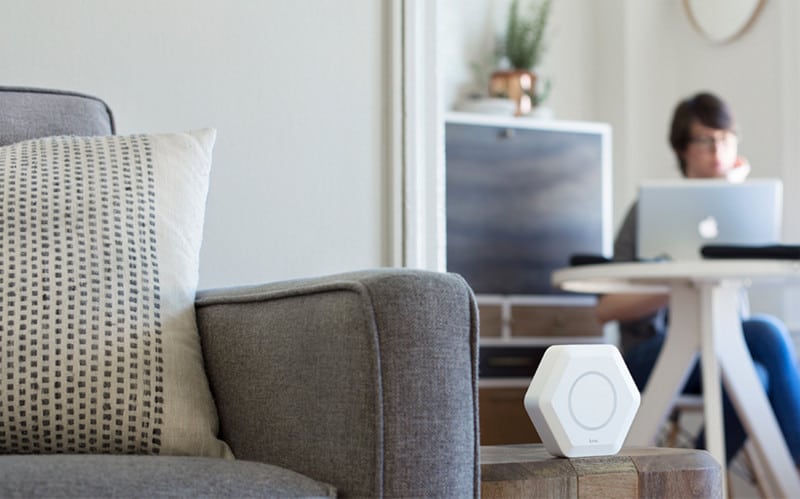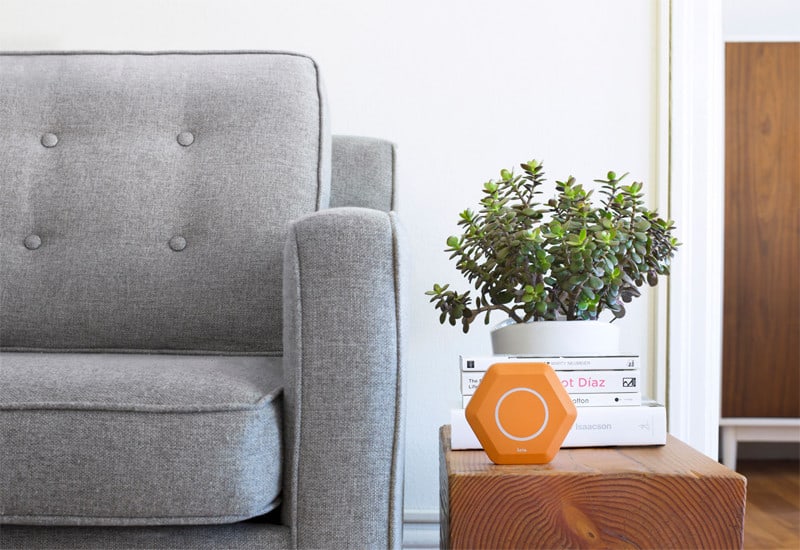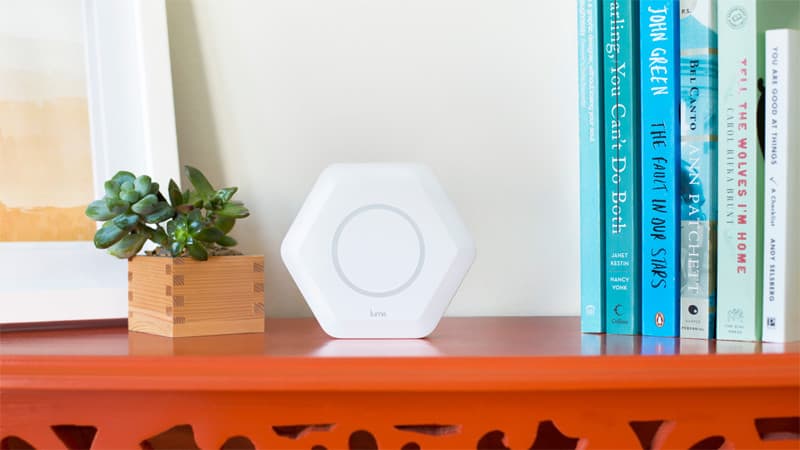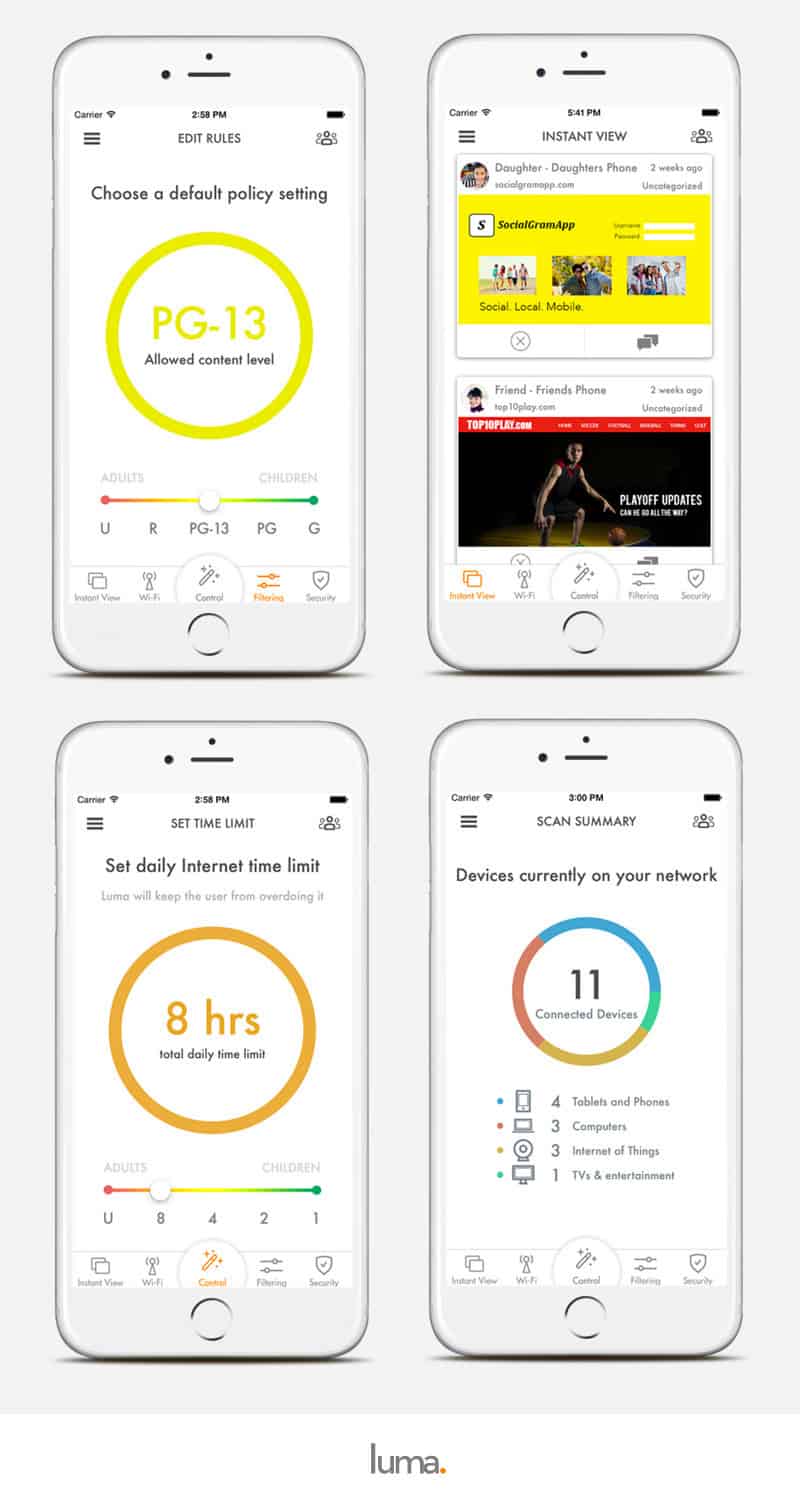Thanks to Luma for sponsoring today's parenting post on the topic of social media and kids.

It happened. My girls and I were out at a dinner party with a few other families. I learned that all the other kids their age already had their own Instagram accounts. It quickly became clear that social media was going to be the next big parenting hurdle I would face with my tween girls.
The first question that came to mind was:
How old should my kids be before I let them use Instagram, Facebook, and other social media sites?
What is your initial reaction? Most social networks require a minimum age of 13 for opening accounts. However, just because they can open an account, should we as parents be allowing it? How do you weigh all the pros and cons of the bouquet of social networks that exist today? (I'd love to hear your thoughts on that in the comments.)
Below you'll find tips for monitoring online behavior, as well as starting points for creating a customized Social Media Contract with your child.
In general, my parenting philosophy has always been in line with the Love & Logic approach. Basically, give children guided independence. Give children the opportunity to learn and make mistakes (when the risks are low), so when they are older, they've had independent decision-making practice (before they get into situations where the consequences are steep). Yet, I admit... when it comes to the internet and social media, I'm hesitant to adopt this parenting approach that works so well in other areas of our lives. The consequences and risks in the online arena often feel much too high to let them dabble out there all on their own.
That being said, I recently attended an eye-opening seminar about cyberbullying at our local high school. Dr. Justin W. Patchin, Co-Director of the Cyberbullying Research Center, made an analogy that has stuck with me the past few weeks... He explained that [to make sure our teens don't hurt themselves or anyone else], we force them to take driver's ed courses in a classroom, to clock hours of behind-the-wheel practice with a certified teacher, and to take both written and on-the-road tests before we hand them a driver's license and our car keys. Yet, parents casually hand their teens a smart phone -- a veritable open door to the perils of the internet and social media -- with a simple preemptive warning, "Make smart choices."
The cyberbullying seminar made me realize that when we DO decide our children are old enough to participate in social media sites, we parents need to support them by providing them with monitored guidance, much like his driver's ed example.

I believe parents of tweens need a three-part, comprehensive approach to social media:
- Creating an explicit contract with your child so both parties have a crystal-clear understanding of expectations and limitations
- Monitoring social networking and online behavior
- Teaching kids to be safe, respectable, and well-intentioned digital citizens while online
How to Guide Your Tween As They Dabble In Social Media
If your kiddo is finishing up grade school or is in middle school, it's time to start thinking about your stance on these topics and approaches. To help get you started, here are three parenting tips that came up time and again in my research for this article:
1 | Keep your conversations about social media with your tween open and candid.
When your teen starts using social media, you want to keep the door open and your conversations candid for two reasons. First, if your child experiences something distressing or unpleasant online, you want them to feel comfortable coming to you to discuss it. Second, you're more likely to gain their buy-in to your family rules if you've already openly discussed a topic and your child feels their voice and opinions were heard and considered.
For example, chat with your kids about reasonable guidelines when it comes to usage time. Tweens and teens will certainly have their own strong opinions about how much time they need. Just to give you an idea of what "average" is for kids these days, I found that boys' and girls' social media preferences are very different. So that's another factor to consider. Teen girls spend 40 minutes more a day than boys on social media (92 minutes per day for girls vs. 52 minutes for boys). [source]
So when you ask your kids about usage time, rather than knocking their suggested quota, use questions to bring final decisions back to a place where both you and they feel comfortable. It's also important to realize that if your son wants less social media time than your daughter, you can perhaps offer more screen time with something like a video game in exchange. Be sure you're not speaking in absolutes and leave some wiggle room to match their different interests and preferences.
SOCIAL MEDIA CONTRACT: Setting clear limits for online behavior with your kids
In the end, you'll want to make sure that you and your child have a crystal-clear understanding of what each of you expects from the other in terms of time limits, parental monitoring, house rules, etc. Consider creating an explicit contract to ensure you're both on the same page when it comes to social media behavior. I found a helpful collection of sample contracts online.
Here are a few of statements from them that stood out to me:
- I will not be on social media for any purpose after _____ a.m./p.m. on a school night or after _____ a.m./p.m. on a non-school night, unless approved.
- I will not say or send anything to anyone online that I wouldn’t be completely comfortable with Mom/Dad hearing, seeing, or knowing about. This includes profanity and any offensive language.
- I will not take and/or send a picture or video of anyone without that person’s permission.
- I will not send hurtful, harassing, threatening, or inappropriate photos and videos on social media, gaming networks, or elsewhere online.
- If I ever feel uncomfortable about an experience online, I will immediately tell Mom/Dad. I understand that Mom/Dad are willing to help me and will not punish me as long as these rules are followed.
When you're ready, you'll want to look through the following three resources with your tween or teen. Then mix and match select statements to create the perfect contract for your family:
2 | Be an active participant on the social media networks your tween is interested in.
Monitor you child's activities online though active participation and supervision. Start by knowing the different social networking sites and apps that exist. This is an ongoing task! Check out this list of social networks currently available to teens. (I admit I work in this industry and even I didn't know quite a few of them.)
Parents need to learn how to search social networking sites their teens visit to see what information they are posting. Make sure you are part of your teen’s “friend list” so you can view their information and verify that their social profiles are set to private, as they should be. Teens post a tremendous amount of information on their online profiles, so it is imperative that they use strict privacy settings and are savvy about the individuals they allow to view their social networking profile.
3 | Make sure your tween knows you'll be monitoring their online social media activities.
Many parents are using additional monitoring tools as part of their comprehensive approach to online safety. The key in this scenario is to ensure your child knows you have an open network. Covertly spying can do more harm than good if your teens feel like their privacy has been violated. Be sure to be transparent about your ability to monitor their actions to avoid this potential pitfall.
I was recently introduced to a new, smart WiFi network device called Luma that is stellar. Check out some of the modern parental controls it offers:
- Set the House Rules. Just say what level of content is (and isn’t) allowed for each person on your network. Luma enforces your rules instantly and very politely -- so you don't have to.
- See Who -- and What -- is Going On. Not only can you see who’s connected to your network, the Luma app also lets you see what your child is doing in real time. Luma makes it easy for you to watch out for your kiddos, even when their bedroom door is closed.
- Off-Network Protection. Luma includes a feature that allows you to manage and monitor devices even when your children are off your network.
- Pause the Internet. We all need to disconnect sometimes. And more often than not, we need a bit of a reminder to do it. The Luma app lets you schedule daily internet curfews for each specific device. It even has a button to instantly pause the internet (like during dinner time!).
Watch this video to learn more about Luma.
After a great deal of thought, I realized a huge part of my fear of social networks had to do with me feeling unprepared for my daughters to make that leap. While I'm still hesitant, I feel a lot more empowered about the situation knowing there are resources like Common Sense Media and products like Luma for me to use to help me guide my kids safely to make the leap into social media.
In the end, when I ask myself...
How old should my kids be before I let them use Instagram, Facebook, and other social media sites?
...for our family, we'll be abiding by the 13-years-old minimum age, and then basing all future decisions on when the girls are mature enough to grasp these three important lessons:
- Respectful behaviors toward themselves and others is a MUST. I want them to be old enough to understand that the rules of respect that apply for interacting with people in real life also apply online. They will also need to demonstrate respect and safety-smarts for themselves. As parents, we'll need to go beyond classic stranger danger and teach our kids the boundary between appropriate and inappropriate conversations (for example, not OK: "Where do you live?"; "What are you wearing?"; "Do you want to have a private conversation?").
- No information is truly private in the online world. My girls will need to be able to understand the harsh lesson that in today's world, photos, texts, and videos can be posted, copied, forwarded, downloaded, and Photoshopped by an online “friend” in the blink of an eye.
- There must be a healthy balance between online and offline activities. This is something that we as parents also need to model for our children. My girls will need to be to an age when they respectfully abide by the set limit we agree to in our family technology contract.
This stat from a recent Common Sense Media study put things into perspective for me:
Social media is an integral part of most teens' lives (45 percent use it "every day"), but only 36 percent say they enjoy using social media "a lot," compared with 73 percent who enjoy listening to music and 45 percent who enjoy watching TV "a lot."
Social media is an integral part of most teens' lives. Let's approach this next parenting hurdle together... openly discussing our approaches, thoughts, and opinions on how best to guide our kids through this digital world.
Let's chat in the comments,

 |
 |
 |
 |
 |
|
 |
|||||
Disclosure of Material Connection: This is a “sponsored post.” The company who sponsored it compensated me via a cash payment, gift, or something else of value to write it. Regardless, I only recommend products or services I use personally and believe will add value to my readers. I am disclosing this in accordance with the Federal Trade Commission’s16 CFR, Part 255: “Guides Concerning the Use of Endorsements and Testimonials in Advertising.”







